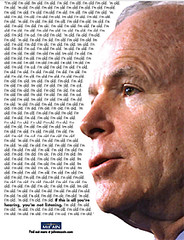While Tamera Kremer at Wildfire was covering the debate between RichardatDell and the fictional AmandaChapel on the value of making brand ambassadors out of employees, Adweek was covering Zappos.com. Zappos has already moved full steam ahead and is one of many companies that already consider employees brand ambassadors online.
In fact, according to the story, the vast majority of trial and repeat business at Zappos.com is driven by word of mouth and employees. Brian Kalma, director of creative services and brand marketing, employs the term "people planning," arguing that each employee needs to be a great point of contact with customers.
Indeed. So where is the debate?
Based on the comments on Wildfire, it seems Chapel was taking the position that “front-line folks that you’ve assigned to the ‘conversation’ on Dell’s behalf, particularly your Twitter social-media team, are making a complete mess of it.”
Richard has defended the Dell position by saying “We believe that social media helps us foster direct relationships, not just transactions with our customers. Think about your own customer relationships and to what extent they rely on the personal and professional interactions that you have.”
Amazingly, the debate seems to have some social media participants questioning the need to distinguish personal and professional brands online, a notion that seems contradictory to any sense of transparency that social media practitioners claim is critical to success. As I noted on Twitter, "trying to separate personal and professional brands is like arguing that you are a different person when you wear jeans or a suit." We can pretend people are somehow different, but it’s really not true.
Still, that is not to say employees acting as brand ambassadors can enjoy a free-for-all online. Common sense suggests if you wouldn’t say something to a customer offline, it’s probably a good idea to avoid saying it online, where it can be archived forever.
Look offline for online behavior guides.
This isn’t rocket science. The best companies already know that employees tend to be the best brand ambassadors, provided the company benefits from a strong internal communication program.
One of the examples I frequently share in explaining the impact of external public relations on internal audiences is how two different utility rate cases turned out. Without sharing the specifics here, one company started with a proactive internal communication program so by the time the rate case hit the papers, employees could explain the reasons behind the rate increase with friends, family, and neighbors. The other did not. The results were dramatically different, with one rate increase succeeding and other quickly turning into a crisis.
My point is simple enough. Front line employees have always been brand ambassadors. It’s not a new concept. So maybe the real question is: do companies realize blogging is front line communication and are they educating their employees well enough for them to deliver a return? Apparently, Zappos does.

In fact, according to the story, the vast majority of trial and repeat business at Zappos.com is driven by word of mouth and employees. Brian Kalma, director of creative services and brand marketing, employs the term "people planning," arguing that each employee needs to be a great point of contact with customers.
Indeed. So where is the debate?
Based on the comments on Wildfire, it seems Chapel was taking the position that “front-line folks that you’ve assigned to the ‘conversation’ on Dell’s behalf, particularly your Twitter social-media team, are making a complete mess of it.”
Richard has defended the Dell position by saying “We believe that social media helps us foster direct relationships, not just transactions with our customers. Think about your own customer relationships and to what extent they rely on the personal and professional interactions that you have.”
Amazingly, the debate seems to have some social media participants questioning the need to distinguish personal and professional brands online, a notion that seems contradictory to any sense of transparency that social media practitioners claim is critical to success. As I noted on Twitter, "trying to separate personal and professional brands is like arguing that you are a different person when you wear jeans or a suit." We can pretend people are somehow different, but it’s really not true.
Still, that is not to say employees acting as brand ambassadors can enjoy a free-for-all online. Common sense suggests if you wouldn’t say something to a customer offline, it’s probably a good idea to avoid saying it online, where it can be archived forever.
Look offline for online behavior guides.
This isn’t rocket science. The best companies already know that employees tend to be the best brand ambassadors, provided the company benefits from a strong internal communication program.
One of the examples I frequently share in explaining the impact of external public relations on internal audiences is how two different utility rate cases turned out. Without sharing the specifics here, one company started with a proactive internal communication program so by the time the rate case hit the papers, employees could explain the reasons behind the rate increase with friends, family, and neighbors. The other did not. The results were dramatically different, with one rate increase succeeding and other quickly turning into a crisis.
My point is simple enough. Front line employees have always been brand ambassadors. It’s not a new concept. So maybe the real question is: do companies realize blogging is front line communication and are they educating their employees well enough for them to deliver a return? Apparently, Zappos does.























